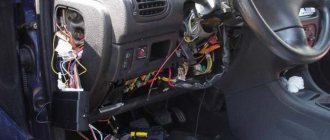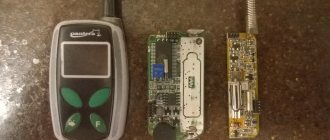System Features
The Tomahawk alarm system is characterized by the following distinctive features:
- The Tomahawk 9030 alarm kit includes a key fob with a liquid crystal display and five keys.
- System of enhanced protection against signal interception.
- The latest Tomahawk TZ 9030 alarm models are equipped with a feedback system to the car owner.
Functionality of the security complex
The Tomahawk 9030 alarm system has earned wide popularity on the Russian market due to the advantages that its use brings. The complex has the following functions:
- "Anti-scanner".
- "Anti-grabber".
- Automatic system diagnostics.
- Automatic engine start.
- Calling the vehicle owner.
- Protection against false positives.
The state of the Tomahawk 9030 alarm system in the event of a sudden shutdown remains unchanged thanks to non-volatile memory. The complex integrates a two-level power sensor and an immobilizer. In model 9030, the activation range of the alarm key fob was increased to 1200 meters.
Other functions of the Tomahawk 9030 system include auto-start and engine blocking, feedback to the car owner, and remote opening of the vehicle’s luggage compartment. The installation of the security system is not affected by the technical features of the car, including the type of gearbox with which the latter is equipped. An advantage of the Tomahawk 9030 car alarm is the engine auto-start function, which is most useful in the cold season: the engine can be started according to the selected operating mode.
Non-volatile memory is also one of the advantages and features of the Tomahawk alarm system. In addition to the above functions, the system has additional options, such as: vehicle search, automatic arming of the car, protection against theft and false alarms, and a two-level shockproof sensor.
How to install?
Installation and connection of the security system is carried out according to the instructions.
The Tomahawk TW-9030 car alarm has a standard connection diagram. Before starting installation, be sure to disconnect the battery by removing the negative terminal.
When installing an alarm system, it is necessary to proceed from the requirements for the location of the components:
- the installation location must provide secrecy and be difficult to reach for intruders;
- There should be no heat sources near the alarm units; installation sites should be protected from moisture and dampness;
- The standard electrical equipment of the car and the alarm components should not influence each other.
Adjusting sensor sensitivity
Numerous sensors included in the system are responsible for the correctness and timeliness of its response. After installing the equipment, their sensitivity must be adjusted. Errors in the operation of car alarms can be caused by incorrect settings, low sensitivity thresholds, or poorly secured sensors in the car. The instructions for the Tomahawk 9030 describe in detail the process of adjusting and configuring the sensors:
- In most cases, service center technicians install car alarm sensors under the front panel of the car. It is advisable to find the location of each of them.
- The key fob starts the security system programming mode.
- The sensitivity scale has 10 levels. As a standard, the sensitivity of the sensors is set at level 4–5.
- Changing the degree of perception of sensors is carried out carefully and gradually while simultaneously checking their performance.
Car alarm Tomahawk TW 9030: owner reviews
Motorists' opinions about the product.
Novel:
I recently bought a car with an already installed alarm system. I searched the forum for a long time and found a complete user manual. Only after that I figured out all the options.
Dmitriy:
Normal whitefish. It just requires special attention and care. Alarm programming is primitively simple and straightforward. If anyone is interested, you can download a PDF file with instructions.
Alexei:
I recently installed a used alarm and am completely satisfied. It works fine, there are no glitches.
Factory reset
To return to factory settings, you must follow the steps given in the instructions for the Tomahawk TZ 9030:
- Turn off the car engine.
- Press the OVERRIDE key nine times in a row.
- Start the engine, which is accompanied by a sound signal.
- Press the OVERRIDE key again once. The car alarm should respond to this action with a sound signal.
- The key with the locks shown on it is pressed.
- The car engine turns off. If the entire procedure is carried out correctly, the car’s parking lights will flash five times in a row.
To reset the remote engine start function to factory settings, you must repeat all the steps described above with one exception: the OVERRIDE key is pressed ten times, not nine. Once the setup is complete, the car will notify the driver with six flashes of parking lights.
How to remove parking mode
On vehicles with a manual transmission, the parking mode is set by raising the handbrake. This action is required when activating remote engine start and other alarm capabilities. To disable this mode, simply lower the lever to the off position.
On an automatic transmission, the modules of the complex are connected to the drive units and independently activate the parking mode when the gearbox lever is on o.
Auto start alarm function
The autostart function is activated after parking the car and shifting the gearshift lever to neutral with the car on the hand parking brake. The corresponding key on the car key fob is pressed, to which the system should respond with a sound signal. After turning off the ignition, all car doors close within thirty seconds. When you press the sound button on the alarm key fob, the display will display the corresponding symbol confirming the activation of the alert.
Basic system functions can be programmed by pressing the OVERRIDE key. In the Tomahawk security complex, OVERRIDE is represented by a large black key with a built-in LED. The button is located in close proximity to the fuse box - in most cases, under the steering column.
User manual
The signaling control unit stores up to four key fobs.
To coordinate the key fob and the system you must:
- Turn off the car.
- Press the OVERR button >
If lost, the key fob will be erased from the alarm memory. Therefore, it is necessary to immediately program all existing key fobs in order to maintain access to the alarm system if the main one is lost.
Programming mode turns off after 6 seconds of inactivity.
A brief guide to programming and using key fobs is presented by the DimASS channel.
Designations of buttons and symbols on the key fob
The main key fob has 5 buttons and an LCD screen. The built-in processor creates and transmits commands to the alarm ECU. Information about the vehicle's condition is constantly available to the user on the LCD.
Signaling functions activated from the main key fob:
- pressing button 2 — arming, closing the central lock (with the engine off);
- pressing button 1 — disarming, opening the central lock (with the engine off);
- pressing button 2 — closing the central lock (with the engine off);
- pressing button 1 — opening the central lock (with the engine off);
- Pressing button 2 twice for a second turns off the shock sensor;
- pressing button 2, pressing button 1 - remote engine start;
- holding down button 1 until the beep, pressing button 2 — automatic hourly engine warm-up;
- holding button 2 until the beep, pressing button 1 — warming up the engine at the preset temperature;
- holding down button 2 until the beep, pressing button 2 turns on the Valet mode;
- pressing button 4 — turn on/off the siren;
- double pressing button 2 — security mode with the engine running;
- double pressing button 3 within a second - search for a car;
- pressing button 2, holding button 1 until the beep — turns on the Anti-Hijack mode;
- pressing button 1 — disables Anti-Hijack mode;
- holding button 1 until the beep, pressing button 3 — turns on/off the immobilizer;
- holding down button 1 until the beep, pressing button 4 — turns on/off automatic arming.
Display icons:
- 1 - shows the operation of the transmitter;
- 2 — security/silent security mode;
- 3 — central locking state: open or closed;
- 4 — battery charge level;
- 5 — Valet mode;
- 6 — fixation of a weak shock (if it lights up with the inscription “PASS”, the warning zone of the shock sensor is disabled);
- 7 — Anti-Hijack mode;
- 8 - timer;
- 9 — alarm clock;
- 10 — hours;
- 11 — fixation of a strong impact (if it lights up with the inscription “PASS”, the main zone of the shock sensor is disabled);
- 12 — temperature units;
- 13 — trunk open;
- 14 — the engine is started;
- 15 — ignition is on;
- 16 — one of the doors is open;
- 17 — auto-arming mode is activated;
- 18 — engine warm-up mode at a preset temperature is activated;
- 19 — immobilizer is turned on;
- 20 — hourly engine start is active;
- 21 — the handbrake is off;
- 22 — key fob buttons are locked;
- 23 — the hood is open.
Setting up autorun
For the autostart to work, the car must be in neutral and the parking brake applied. A car with automatic transmission is in Parking mode.
Setting up automatic hourly engine starting is done as follows:
- To turn an option on or off, press and hold button 1.
- After a sound signal or the LED color changes to green, button 2 is pressed.
When the function is activated, the car’s engine will start at intervals of 1, 2, 4 or 24 hours. “2-1 DAILY” will appear on the display.
Setting up automatic engine warming up at a given temperature:
- Press and hold button 2.
- After the key fob sends a signal, you need to press button 1. “1-2 TEMP START” and the temperature that was programmed to initiate warming up will appear on the screen.
The car engine starts for a set time interval when the set temperature is reached.
The auto-warm-up function is activated no more than once every 2 hours.
The temperature at which engine starting is initiated is set as follows:
- Turn off the car.
- Press the OVERR button >Download the installation and operating instructions for the Tomahawk TW-9030 alarm system in PDF format
The service manual, which will allow you to use and configure the alarm, can be downloaded from the link:
| Manuals in Russian for operation and installation of alarm systems | |
| Operating and installation instructions for Tomahawk TW-9030 |
Malfunctions of the Tomahawk 9030 car alarm
There may be several reasons why the alarm system does not respond to pressing the key fob keys:
- Low key fob battery.
- The need to reconfigure the key fob.
- Presence of radio interference in the car parking area.
Contacting the service center, whose technicians installed the security system, is required if there are more serious malfunctions - for example, the fuel pump does not respond to the start command from the alarm. The central locking drive is diagnosed if the car doors do not lock after pressing the key fob keys. If problems arise with the key fob, the first thing to check is its battery. The key fob is reprogrammed if replacing the battery does not correct the defect in operation.
If there is a problem with the communication module cable, the car owner is notified by the system via a light signal - the car's headlights flash ten times in a row. Unreasonable activation of the security system in most cases is caused by a malfunction or incorrectly set sensitivity of the sensors, which can be corrected by adjusting them.
Installation of the Tomahawk alarm system
Installation of the Tomahawk 9030 car security system requires compliance with some nuances:
- The electronic control unit is located inside the car.
- The siren is installed in the engine compartment.
- Power supply, central locking and side lights must be protected by fuses.
- Impact sensors are located inside the car.
Additional sensors can be attached in any places chosen by the master. It is advisable to entrust the connection and configuration of the system to the service center specialists.
Car alarm management
All control of the Tomahawk system is tied to two key fobs included in the kit. The display of the main control panel displays symbols indicating the functions of the complex. The instruction manual provides a complete description of each option and symbols. The key fob allows you to perform the following actions:
- Change in temperature inside the car.
- Vehicle location tracking.
- Remote closing and opening of the luggage compartment.
- Starting the engine using a timer.
The system status is displayed on the key fob display. Thanks to its wide functionality and the availability of additional options, the Tomahawk 9030 system is simple and easy to use, reliable and efficient.
Basic information
The Tomahawk TV alarm system is made using the latest technologies. Equipped with the most modern options. These include the following functions:
- "anti-grabber";
- "anti-scanner".
In addition, car alarms are designed to protect the car’s hood, doors and ignition system from hacking. The main task is to protect the car from theft and prevent the engine from starting.
In addition to the main lock, an additional one is built in. This solution ensures good safety during system operation. Each device has its own individual PIN code. If necessary, the car is emergency disarmed and automatically goes into quiet mode. A special key fob is included for control and connection.
The main devices are shock sensors. Thanks to them, the potential danger to the car is determined. The operating principle of the TV security system is based on a two-level shock sensor. For ease of use, there are several operating modes and different control methods. The kit includes rules and a manual for the system, so every driver can figure it out.
Most popular features:
- Panic mode.
- "Silent" security mode.
- "Valet" mode.
- Anti-hi-jack mode.
Valet mode
When performing vehicle maintenance, the Tomahawk alarm system is switched to Valet mode, which imposes certain restrictions on the functionality of the system: activation of security and auto-start of the engine become unavailable. This mode is essentially a service mode. Its inclusion is carried out as follows:
- The car is disarmed.
- On the key fob, press and hold key 1.
- After a melodic signal, the key is pressed again.
In the case of the Tomahawk TZ 9030 model, the manufacturer provides an additional method for activating the mode that does not require a key fob:
- The engine starts when the security mode is disabled.
- The OVERRIDE key is held down for three seconds.
The system is switched to Valet mode after completing the above steps.
The mode is turned off in a similar way. When Valet mode is active, the corresponding symbol is displayed on the key fob display. There is an LED on the antenna unit, which must operate continuously.
Disabling the Valet mode during repair and service work can be caused by the closure of the OVERRIDE contacts.
Connecting and setting up autorun in Tomahawk TW-9010 and TZ-9030
Very often, when connecting a car alarm on their own, they make mistakes when connecting the car’s ignition wires. If the owner does not need autostart, it is easier not to touch the ignition switch contacts.
But sooner or later, the autostart option may be required, and then you need to correctly determine which contacts come from the standard lock block. Next we look at how to connect the Tomahawk TZ-9030 and TW-9010 alarms to these contacts.
The difference is that the second model is equipped with a blocking relay. How to configure the autorun option is also discussed.
Ignition switch wire designations
Look at the diagram shown in the figure.
Terminal block with two starter contacts
The above does not mean that both cords can be connected together and connected using the circuits discussed here. The diagrams indicate one wire (ST1) that makes up the starter power circuit. This option is suitable:
- For all domestic cars without exception;
- For new foreign cars;
- For foreign cars up to 90-91 years of manufacture.
This is the paradox - the “ST2” cord is not provided in the new, as well as in the oldest models.
Diagram for TZ-9030
Here's how to connect the Tomahawk TZ-9030 main unit to the ignition switch to use autostart.
Of course, after installation, you need to do programming, which is discussed below.
If the use of a lineman is required, connect it to the terminal of the main alarm connector (black and red cord). The power connector, in turn, has the following wiring.
Instructions for equipment TZ-9030
If we talk about the Tomahawk TW-9010 model, the purpose of the IGN3 pin will be different from what is being considered here.
In "Chapter 1" the designations were listed: IGN1, IGN2, ACC, starter wire (ST). The “IGN3” cord has been added here, but it replaces the ACC wire.
The “blue” cord coming out of the alarm terminal block must be connected to the ACC contact, otherwise the autostart will not work.
At the same time, if you make changes to the settings, the IGN3 pin can be connected to the ST2 pin. True, it is not clear how to “emulate” the ACC wire then.
A “T” connection is used when connecting to all wires except the starter. And the “ST” cord needs to be cut to connect the resulting ends with the black and yellow wires. The cable that goes to the alarm from the lock is a signal cable (thin).
Diagram for TW-9010
A non-standard method of switching starter current is typical for the following alarm model: Tomahawk TW-9010. Voltage is supplied here from the 6-pin power terminal block when autostart is performed.
The rest of the time, the starter wire conducts current, even if the car alarm does not work or does not work correctly. A blocking relay is included in the gap in the standard wiring. Whether it can be removed from the scheme is unknown.
It is better, therefore, to stick to the recommended option.
Current loop without blocking
The conclusion follows from the previous paragraph: autostart is needed - do not remove the blocking relay from the circuit. You can install a “bug” in the socket, but then the appearance of a “current loop” cannot be ruled out. It turns out that the blocking option is “loaded” with autostart.
Note that the Tomahawk TW-9010 and TZ-9030 alarms can control the immobilizer bypass. The lineman’s “negative” cord is connected to the black-red cable (figure at the beginning of the chapter). The latter is designed to be connected to the “IGN3” pin, but in most cars this option is not used.
The ground potential on the black-red cord appears before the starter starts, which is exactly what is required for the lineman to work. In general, everything looks strange: in alarms with auto-start, they often provide a separate output intended only for connecting a lineman.
Connection in vehicles with "ST2"
Let’s say that voltage appears simultaneously at the starter contacts “ST1” and “ST2”. Then the alarm installation diagram can be modified.
Modified circuit for TW-9010
The break in the “ST2” wire coming from the lock contains normally closed relay contacts. In theory, the standard wiring of the “ST2” circuit is not broken here. But when a positive potential appears on contact “ST1”, such potential will also appear on “ST2”.
If the voltage should appear at contact “ST2” later than at “ST1”, you need to install a relay with a delay. But this option is not recommended. But the IGN3 output, provided in the TZ-9030 car alarm, can “emulate” the “ST2” contact in any car. You need to be able to configure the option correctly, and then the following connection option will become possible:
- IGN1 signaling –> IGN1 auto;
- IGN2 –> ACC (if IGN2 is not present in the car itself);
- IGN3 –> relay winding connected to the ST2 gap.
We hope everything is clear here.
Two starter wires and TZ-9030
There are models of devices with auto-start, where connection to two starter lines is provided initially. However, it turns out that there is no such alarm in the Tomahawk equipment line.
Programming signaling parameters
Let's start by setting the purpose of the “IGN3” cord coming out of the power connector of the TZ-9030 alarm system. The default value is "ACC wire". Other options are also acceptable:
- ST2, voltage appears when the starter is running (value 3);
- ST2 with the appearance of voltage before the starter starts (value 4).
To set what is required, go to the programming mode: turn off the ignition, press the Override button 6 times, turn on the ignition. Then press the Override button once and select a value using the key fob button.
Auto start programming, TZ-9030
Which value corresponds to which button is shown in the table. Of interest is “option 2”. Here you can choose how long the car alarm will rotate the starter. In order, the values are: 0.8, 1.2, 2, 3.6 s.
Note that the latter cannot be selected if engine control by tachometer is not configured. The tachometer or crankshaft sensor is connected to the main connector (gray-black cord). But this connection itself is not always easy to make.
If you press the Override button not 6 times, but 5 times, you will enter the standard options programming mode. Option “10” for the Tomahawk TZ-9030 model is responsible for the temperature at which the engine will turn on to warm up. The values are in the following order: -5, -10, -20, -30.
To activate and also disable the automatic warm-up option, press and hold the “Silent Security” button. The key fob will emit a signal (or change the color of the LED), and then press the “LOCK/UNLOCK” key. To set hourly switching on, two keys must be pressed in reverse order. First “LOCK/UNLOCK” and so on.
Signal key fobs TZ-9030 and TW-9010
Please note that when the car is removed from the handbrake, the options will not work.
For an “earlier” signaling model, that is, for the Tomahawk TW-9010, everything looks more complicated. To activate or disable the “temperature” start, press and hold the following combination: “Key” and “Trunk”. You can also set up a timed start: press and hold the combination “Key” - “Silent security”. In 5 seconds you need to set the value:
- Hourly – “Lock” key;
- Once every 2 hours – “Key”;
- 4 hours – “Trunk”;
- 12 – “Silent security”.
The value “24 hours” corresponds to no pressing.
Additional information for TW-9010
It was said that the TW-9010 car alarm can turn on the engine based on temperature. To set the required value, enter the programming mode: turn on the ignition (engine off), press the Override button 6 times, turn off the ignition. Select the option with the required number (in this case “2”) by pressing the button the appropriate number of times.
Based on the data given here, the starter operating time is also determined.
Note that the value "3000" is only used when tach control is active.
You can activate the daily start: press the Override button 4 times. Before doing this, you need to turn off the ignition, and after setting the mode, turn it on. You can also enable temperature triggering: instead of pressing 4 times, use 5 times. The trigger value (on/off) can be changed by pressing once. One “beep” corresponds to the “on” value, two – to the “off” value.
Tomahawk signal and automatic start
Of course, after installation, you need to do programming, which is discussed below. If the use of a lineman is required, connect it to the terminal of the main alarm connector (black and red cord).
The power connector, in turn, has the following wiring.
Instructions for the TZ-9030 equipment If we talk about the Tomahawk TW-9010 model, the purpose of the IGN3 pin will be different from that discussed here.
In "Chapter 1" the designations were listed: IGN1, IGN2, ACC, starter wire (ST). The “IGN3” cord has been added here, but it replaces the ACC wire. The “blue” cord coming out of the alarm terminal block must be connected to the ACC contact, otherwise the autostart will not work. At the same time, if you make changes to the settings, the IGN3 pin can be connected to the ST2 pin.
True, it is not clear how to “emulate” the ACC wire then. A “T” connection is used when connecting to all wires except the starter.
Tomahawk 9010, 9020 and 9030 Alarm: Installation and Application Guide
The model allows you to use different security modes with different methods of alerting and responding to an attempted theft. Even car enthusiasts without experience will be able to understand the circuits and install, program or reprogram the alarm with their own hands.
The TZ 9020 model has all the standard features that are installed on Tomahawk alarms.
In addition, it has additional features: starting the engine from a distance; the system responds at a distance of up to 1.2 km; there are shock and vibration sensors; warning about open doors; receiving
Tomahawk tw-9030, III.
connecting the system – Tomahawk TW-9030 Operating Instructions
Connect to the starter wire at the ignition switch. Main connector 14 PIN. 1. Gray-black wire - engine running control input.
Connect to the oil pressure sensor or tachometer (see 5. Blue wire - output “-” control of courtesy lighting or control of power windows (300mA max).
6. Black-red wire -“-” 300mA in remote start mode to bypass the sensors of the standard security system or locking.
7. Black and yellow wire - output “-” 300 mA control on the blocking relay.
8. Gray wire - output “+” control of a siren or standard horn (1.5A max, programmable).
9.
Signaling Tomahawk-9010 and VAZ-2110
You can connect a blocking relay connected to the “black-yellow” cable if autostart is needed. In general, connecting the Tomahawk tw 9010 signaling system is a pleasure if we are talking about a VAZ-2110. There are two connectors under the dashboard of the VAZ 10s.
When making T-shaped connections, the following wires are pulled from the connectors:
- Tachometer cord connected to pin “3” of the white connector;
- Parking brake sensor wire (white connector);
- Two cords from the turn signal lamps (terminals 5 and 6 of the red connector).
All Tomahawk car alarm systems allow the starter to be disabled. If the owner needs this option, then a relay is connected to the break in the “50P” cord.
Connecting to the ignition switch Blocking using an “external relay” is a standard option for the Tomahawk tw 9010 alarm, unlike the tz 9030 systems. If blocking is not needed, still connect the “yellow” cord of the 6-pin connector to the “15GC” terminal.
Instructions for use of car alarm Tomahawk TW-9030
Ivan Tomahawk TV 9030 is a professional anti-theft alarm with feedback, providing exceptional reliability from the use of an intercepted signal thanks to the anti-grabber.
Detailed instructions for the Tomahawk TW 9030 greatly simplify the process of installing the alarm and setting up security and autostart.
Open full content [ Hide ] Basic technical data of the alarm: the nominal voltage of the vehicle's on-board network is 12 V; when the ignition is turned off, the working alarm consumes only 16 mAh; data exchange between the key fob and the main unit occurs at a frequency of 434 MHz FM; range between the key fob and electronic alarm blog is 1200 meters (may be reduced in the presence of interference); key fobs are powered











